1. Introduction
In the previous tutorials in this series about cellular respiration, we’ve seen how glycolysis, the link reaction, and the Krebs cycle oxidize food so that the mobile electron carriers NAD+ and FAD can be reduced to NADH and FADH2, respectively.
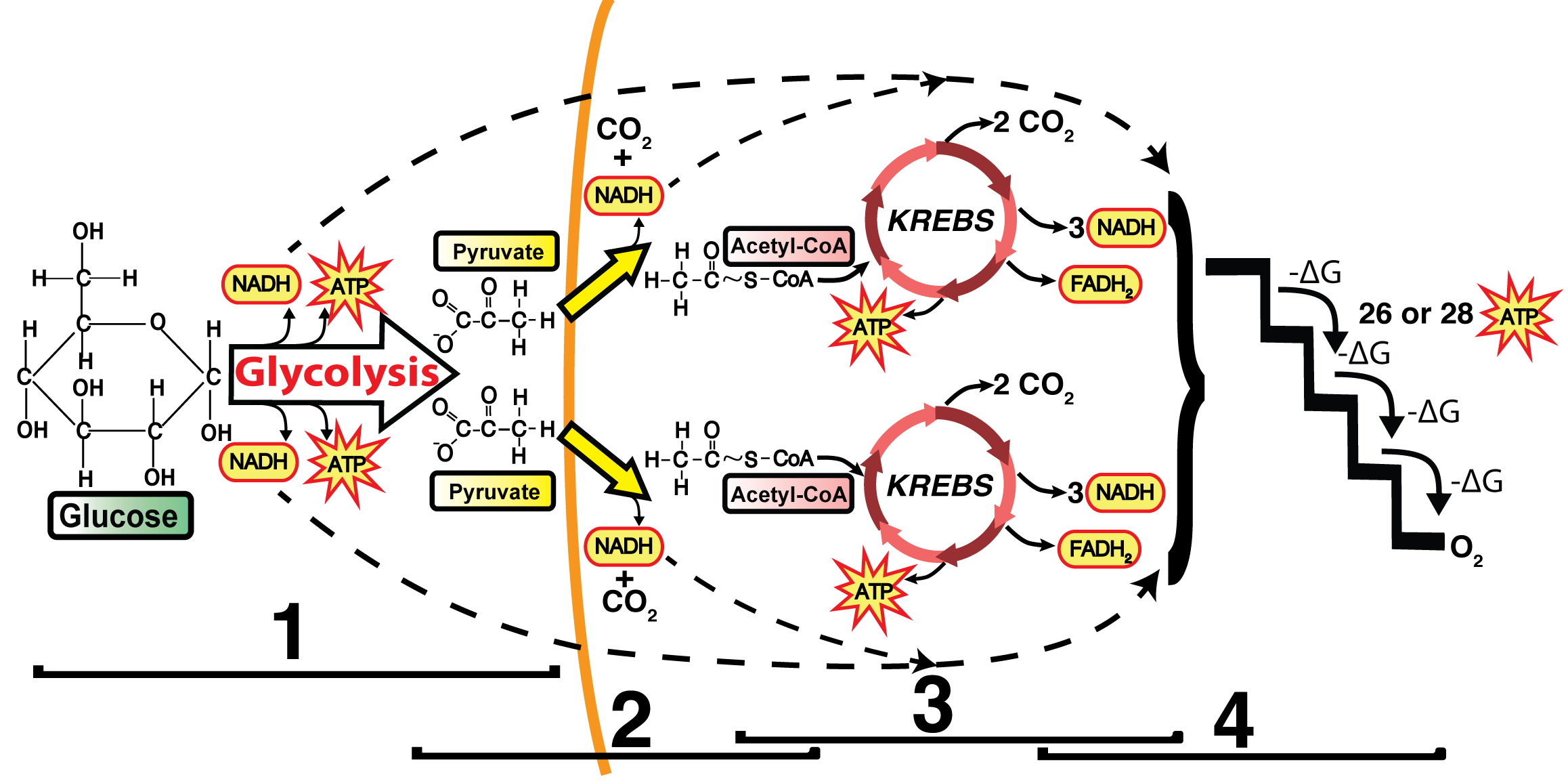
NADH and FADH2 can be thought of as rechargeable batteries that are fully charged. If you took a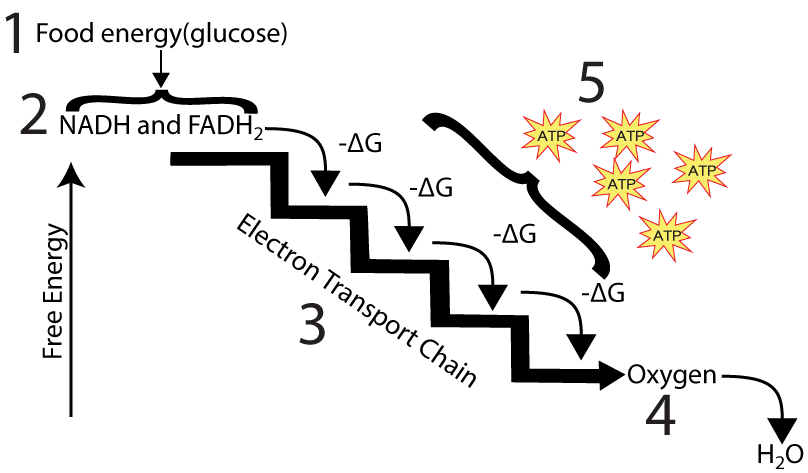 charged up battery and placed it in a flashlight or a radio, then that battery could release a flow of electrical energy that could, in turn, power some work. In the case of a flashlight, that work would be providing light. In the case of the radio, it would be converting radio waves into sound.
charged up battery and placed it in a flashlight or a radio, then that battery could release a flow of electrical energy that could, in turn, power some work. In the case of a flashlight, that work would be providing light. In the case of the radio, it would be converting radio waves into sound.
In cells, an analogous thing happens. As shown at left form below, NADH and FADH2 deliver electrons to the electron transport chain. The electron transport chain is a series of proteins that are embedded in the inner membrane of the mitochondria.
As electrons flow along the chain, the proteins in the chain do the work of setting up the conditions for ATP creation. Let’s see how this process works.
2. Mitochondria: Structure and Function
ATP synthesis in the mitochondria is a beautiful example of one of biology’s most important ideas: the relationship between structure and function. The quiz below will let you master the key structures involved. Then we’ll move on to the process.
[qwiz qrecord_id=”sciencemusicvideosMeister1961-mitochondria S and F (HS)”]
[h]Interactive Diagrams: Mitochondrial Structure
[i]
[q labels = “top”]
[l]cell exterior
[f*] Excellent!
[fx] No, that’s not correct. Please try again.
[l]cell membrane
[f*] Excellent!
[fx] No. Please try again.
[l]cytoplasm
[f*] Excellent!
[fx] No, that’s not correct. Please try again.
[l]inner membrane
[f*] Good!
[fx] No. Please try again.
[l]intermembrane space
[f*] Good!
[fx] No, that’s not correct. Please try again.
[l]matrix
[f*] Excellent!
[fx] No, that’s not correct. Please try again.
[l]mitochondrion
[f*] Correct!
[fx] No. Please try again.
[l]outer membrane
[f*] Correct!
[fx] No. Please try again.
[q labels = “top”]
Here’s a more detailed depiction of a mitochondrion. You should be able to label all of the parts, with the possible exception of one. ATP Synthase is a protein channel and an enzyme that’s embedded in the mitochondrial membrane. See if you can figure it out as you label the diagram below.
[l]ATP Synthase
[f*] Excellent!
[fx] No, that’s not correct. Please try again.
[l]chromosome
[f*] Great!
[fx] No. Please try again.
[l]cytoplasm
[f*] Good!
[fx] No, that’s not correct. Please try again.
[l]inner membrane
[f*] Great!
[fx] No, that’s not correct. Please try again.
[l]intermembrane space
[f*] Excellent!
[fx] No. Please try again.
[l]matrix
[f*] Good!
[fx] No. Please try again.
[l]outer membrane
[f*] Great!
[fx] No, that’s not correct. Please try again.
[q] Now we’re going to zoom in on the outer boundary of the mitochondrion. Just focus on the letters (you’ll learn about all the numbered parts later). Which letter is the inner membrane?
[textentry single_char=”true”]
[c]IE Q=
[f]IEV4Y2VsbGVudC4gJiM4MjIwO0QmIzgyMjE7IGlzIHRoZSBpbm5lciBtaXRvY2hvbmRyaWFsIG1lbWJyYW5lLg==[Qq]
[c]IEVudGVyIHdvcmQ=[Qq]
[c]ICo=[Qq]
[f]IE5vLiBIZXJlJiM4MjE3O3MgYSBoaW50OiBub3RpY2UgdGhhdCB0aGVyZSBhcmUgdHdvIGxpcGlkIGJpbGF5ZXJzLiBJZiAmIzgyMjA7QSYjODIyMTsgaXMgdGhlIGN5dG9wbGFzbSwgd2hpY2ggbWVtYnJhbmUgaGFzIHRvIGJlIHRoZSBpbm5lciBtZW1icmFuZT8=[Qq]
[q] Which letter is the outer membrane?
[textentry single_char=”true”]
[c]IE I=
[f]IEV4Y2VsbGVudC4gJiM4MjIwO0ImIzgyMjE7IGlzIHRoZSBvdXRlciBtaXRvY2hvbmRyaWFsIG1lbWJyYW5lLg==[Qq]
[c]IEVudGVyIHdvcmQ=[Qq]
[c]ICo=[Qq]
[f]IE5vLiBIZXJlJiM4MjE3O3MgYSBoaW50OiBub3RpY2UgdGhhdCB0aGVyZSBhcmUgdHdvIGxpcGlkIGJpbGF5ZXJzLiBJZiAmIzgyMjA7QSYjODIyMTsgaXMgdGhlIGN5dG9wbGFzbSwgd2hpY2ggbWVtYnJhbmUgaGFzIHRvIGJlIHRoZSBvdXRlciBtZW1icmFuZT8=[Qq]
[q] Which letter indicates the inter-membrane space?
[textentry single_char=”true”]
[c]IE M=
[f]IEV4Y2VsbGVudC4gJiM4MjIwO0MmIzgyMjE7IGlzIHRoZSBpbnRlci1tZW1icmFuZSBzcGFjZS4=[Qq]
[c]IEVudGVyIHdvcmQ=[Qq]
[c]ICo=[Qq]
[f]IE5vLiBIZXJlJiM4MjE3O3MgYSBoaW50OiBub3RpY2UgdGhhdCB0aGVyZSBhcmUgdHdvIGxpcGlkIGJpbGF5ZXJzLiBXaGljaCByZWdpb24gbXVzdCBiZSB0aGUgc3BhY2UgYmV0d2Vlbg==IHRoZXNlIHR3byBtZW1icmFuZXMsIGFsc28ga25vd24gYXMgdGhlICYjODIyMDtpbnRlci1tZW1icmFuZSBzcGFjZS4mIzgyMjE7[Qq]
[q] Which letter indicates the cytoplasm?
[textentry single_char=”true”]
[c]IE E=
[f]IEV4Y2VsbGVudC4gJiM4MjIwO0EmIzgyMjE7IGlzIHRoZSBjeXRvcGxhc20u[Qq]
[c]IEVudGVyIHdvcmQ=[Qq]
[c]ICo=[Qq]
[f]IE5vLiBIZXJlJiM4MjE3O3MgYSBoaW50OiBub3RpY2UgdGhhdCB0aGVyZSBhcmUgdHdvIGxpcGlkIGJpbGF5ZXJzLiBXaGljaCByZWdpb24gaXMgb3V0c2lkZSBvZiB0aGUgb3V0ZXIgbWVtYnJhbmUgKGFuZCBtdXN0LCB0aGVyZWZvcmUsIGJlIHRoZSBjeXRvcGxhc20pPw==[Qq]
[q] Which letter indicates the mitochondrial matrix?
[textentry single_char=”true”]
[c]IE U=
[f]IEV4Y2VsbGVudC4gJiM4MjIwO0UmIzgyMjE7IGlzIHRoZSBtaXRvY2hvbmRyaWFsIG1hdHJpeC4=[Qq]
[c]IEVudGVyIHdvcmQ=[Qq]
[c]ICo=[Qq]
[f]IE5vLiBIZXJlJiM4MjE3O3MgYSBoaW50OiBub3RpY2UgdGhhdCB0aGVyZSBhcmUgdHdvIGxpcGlkIGJpbGF5ZXJzLiBXaGljaCByZWdpb24gaXMgaW5zaWRlIG9mIHRoZSBpbm5lciBtZW1icmFuZSAoYW5kIG11c3QsIHRoZXJlZm9yZSwgYmUgdGhlIG1hdHJpeCwgd2hpY2ggaXMgdGhlIGN5dG9wbGFzbSBvZiB0aGUgbWl0b2Nob25kcmlvbik/[Qq]
[/qwiz]
3. It starts with pumping protons
So, that’s the overall structure. Let’s focus on the electron transport chain, in the inner mitochondrial membrane.
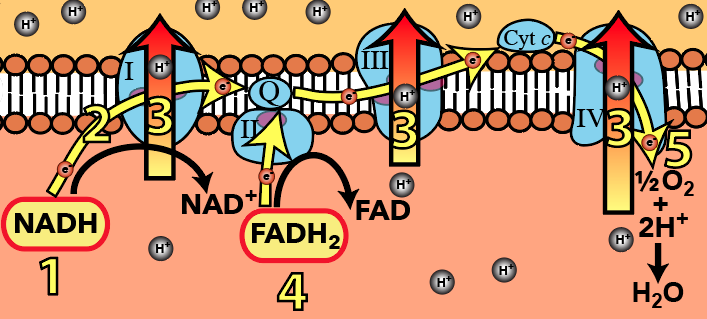
The chain is a series of proteins organized in a sequence in the inner mitochondrial membrane. Organized in this way, you can imagine them as a type of molecular “wire” that allows electrons donated by NADH and FADH2 to flow.
The electron flow pathway is shown above at number “2,” with “1” being electron donation by NADH, and “4” being electron donation by FADH2. Each of these donations result in NADH becoming its oxidized counterpart NAD+, and FADH2 becoming FAD.
At the very end of the chain (at “5”), electrons flow to oxygen. As oxygen accepts electrons, it also grabs protons from the matrix. This reduces oxygen to water, the second waste product of cellular respiration.
Looking at the diagram above, we can see why oxygen is so important. Oxygen is the final electron acceptor in the electron transport chain. Without oxygen, electrons don’t flow. And if electrons don’t flow, the work that makes ATP synthesis possible won’t happen. Life, very quickly, grinds to a halt.
And what is this work? The work is pumping protons from the mitochondrial matrix (region “E”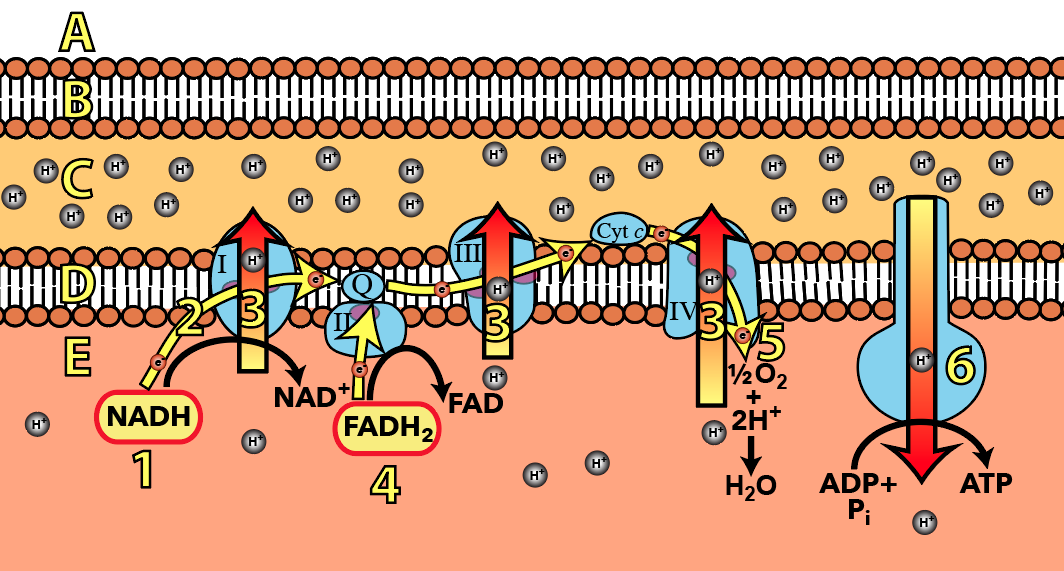 ) to the intermembrane space (region “C”). In this diagram, proton pumps are indicated by the number “3”, and there are three different ones shown. They’re numbered I, III, and IV.
) to the intermembrane space (region “C”). In this diagram, proton pumps are indicated by the number “3”, and there are three different ones shown. They’re numbered I, III, and IV.
All of these pumps are doing the same thing, and they’re all powered by the same energy source: the flow of electrons along the electron pathway (again, at number “2”). Note that this is active transport: the pumps are pumping up a concentration gradient, from where protons are less concentrated (in the matrix) to where they’re more concentrated (in the intermembrane space).
4. It ends with making ATP
Pumping protons from the matrix to the intermembrane space creates a gradient that the cell harvests to make ATP.
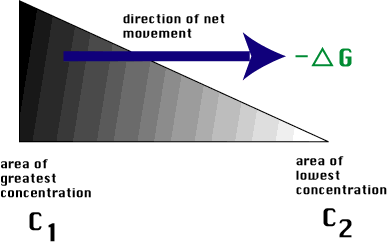
Protons are charged particles. The phospholipid bilayer that makes up both the inner membrane (“D,” above) and the outer membrane (“B”) is impermeable to charged particles. Consequently once protons are pumped into the intermembrane space (“C”), they’re trapped there.
Energetically, you can imagine those protons as being on the left side of the gradient diagram on your left. They’re like rocks positioned on a step slope, ready to role down. As they role, their kinetic energy can be used to do some work for the cell.
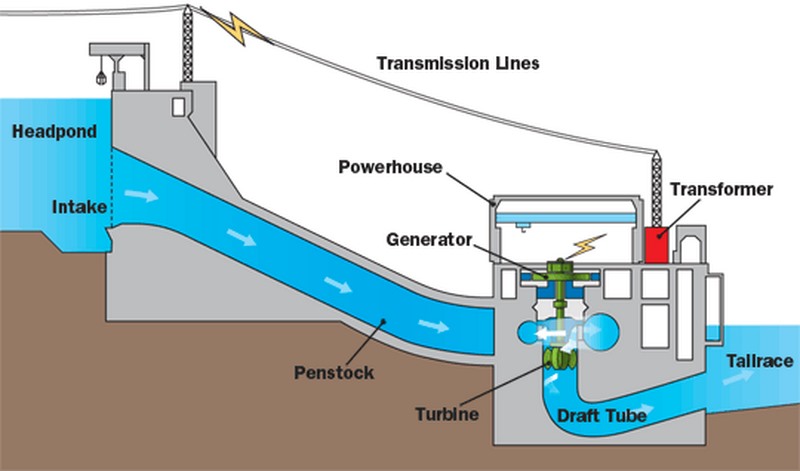
An even better analogy is to think of these trapped protons as being like water trapped behind a dam. So let’s think for a minute about how a hydroelectric power station works. In the diagram at right, the water behind the dam is stored in a headpond. When the intake is opened, that water flows through a channel (the penstock) which brings it to a turbine. The force of the water flowing through the turbine forces the turbine to rotate, which powers an electrical generator.
In a mitochondrion, the protons are trapped in the intermembrane space. Because they’re in much higher concentration in the intermembrane space than in the matrix, their tendency will be to diffuse out of the intermembrane space, and back to the matrix. On top of that, there’s another force at work. Protons are positively charged particles. Like charges repel. While protons don’t have feelings, you can imagine them as “wanting” to get away from all the other positively charged protons that are surrounding them in the intermembrane space.
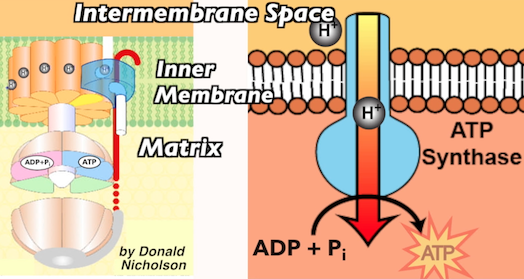 There’s only one way for protons to get back to the matrix, and that’s through a protein channel and an enzyme called ATP synthase. ATP synthase has binding sites for ADP and Pi (inorganic phosphate). When protons diffuse through ATP synthase, their kinetic energy (energy of motion) causes these binding sites to change shape. This catalyzes formation of a bond between ADP and Pi, transforming them into ATP.
There’s only one way for protons to get back to the matrix, and that’s through a protein channel and an enzyme called ATP synthase. ATP synthase has binding sites for ADP and Pi (inorganic phosphate). When protons diffuse through ATP synthase, their kinetic energy (energy of motion) causes these binding sites to change shape. This catalyzes formation of a bond between ADP and Pi, transforming them into ATP.
Here’s how I describe this process in my Electron Transport Chain music video:
ATP synthase is embedded in the inner membrane
How it works is so cool it’s insane.
It’s got channels for diffusing protons running right through it.
When cells make ATP, well watch how they do itThe matrix side of ATP synthase has binding sites
For ADP and P which come in and bind.
And as ATP synthase lets protons barge through
Their kinetic energy gets put to use.Like water through a turbine proton movement generates rotation.
Changing synthase’s binding site conformation.
Which catalyzes chemical bond formation.
ADP and P make ATP that energy sensation!
That’s it. That’s how cells, in aerobic respiration, make ATP.
5. Quiz. The Electron Transport Chain
Got it? Consolidate what you’ve learned above with the following quiz.
[qwiz qrecord_id=”sciencemusicvideosMeister1961-Electron Transport Chain (HS)”]
[h]Quiz: The electron transport chain
[i]
[q]In the diagram below, which number represents the part where you’d find ATP synthase?
[textentry single_char=”true”]
[c]Ng ==[Qq]
[f]IFllcywg4oCcNuKAnSBpcyB0aGUgaW5uZXIgbWl0b2Nob25kcmlhbCBtZW1icmFuZSwgd2hpY2ggaXMgd2hlcmUgQVRQIHN5bnRoYXNlIGlzIGxvY2F0ZWQu[Qq]
[c]Kg==[Qq]
[f]Tm8uIEhlcmUmIzgyMTc7cyBhIGhpbnQuIEFUUCBzeW50aGFzZSBnZW5lcmF0ZXMgQVRQIGFzIHByb3RvbnMgZmxvdyBmcm9tIHRoZSBpbnRlcm1lbWJyYW5lIHNwYWNlIHRvIHRoZSBtYXRyaXguIFdoZXJlIHdvdWxkIEFUUCBzeW50aGFzZSBoYXZlIHRvIGJlIGxvY2F0ZWQgaW4gb3JkZXIgdG8gYWxsb3cgZm9yIHRoaXM/
Cg==
[q]In the diagram below, which number represents the part where you’d find the electron transport chain?
[textentry single_char=”true”]
[c]Ng ==[Qq]
[f]IFllcywg4oCcNuKAnSBpcyB0aGUgaW5uZXIgbWl0b2Nob25kcmlhbCBtZW1icmFuZSwgd2hpY2ggaXMgd2hlcmUgdGhlIGVsZWN0cm9uIHRyYW5zcG9ydCBjaGFpbiBpcyBsb2NhdGVkLg==[Qq]
[c]Kg==[Qq]
[f]Tm8uIEhlcmUmIzgyMTc7cyBhIGhpbnQuIFRoZSBlbGVjdHJvbiB0cmFuc3BvcnQgY2hhaW4gcHVtcHMgcHJvdG9ucyBmcm9tIHRoZSBtYXRyaXggdG8gdGhlIGludGVybWVtYnJhbmUgc3BhY2UuIFdoZXJlIHdvdWxkIGl0IGhhdmUgdG8gYmUgbG9jYXRlZCBpbiBvcmRlciB0byBhbGxvdyBmb3IgdGhpcz8=
Cg==
[q]In the diagram below, which number represents the area that protons get pumped into?
[textentry single_char=”true”]
[c]Nw ==[Qq]
[f]IFllcy4g4oCcN+KAnSBpcyB0aGUgaW50ZXJtZW1icmFuZSBzcGFjZSwgd2hpY2ggaXMgd2hlcmUgcHJvdG9ucyBnZXQgcHVtcGVkIGludG8gaW4gb3JkZXIgdG8gY3JlYXRlIGEgY29uY2VudHJhdGlvbiBncmFkaWVudCBmb3Igc3ludGhlc2l6aW5nIEFUUC4=[Qq]
[c]Kg==[Qq]
[f]Tm8uIEhlcmUmIzgyMTc7cyBhIGhpbnQuIFRoZSBwcm90b25zIHN0YXJ0IGluIHRoZSBtYXRyaXguIFdoZXJlIGNvdWxkIHRoZXkgZ28gdG8gaW4gb3JkZXIgdG8gY3JlYXRlIGEgY29uY2VudHJhdGlvbiBncmFkaWVudCBmb3Igc3ludGhlc2l6aW5nIEFUUD8=
Cg==[Qq]
[q]In the diagram below, which number represents the area that protons flow to as they flow through ATP synthase, making ATP?
[textentry single_char=”true”]
[c]NQ ==[Qq]
[f]IFllcy4g4oCcNeKAnSBpcyB0aGUgbWF0cml4LCB3aGljaCBpcyB3aGVyZSBwcm90b25zIGZsb3cgdG8gYXMgdGhleSBmbG93IGZyb20gdGhlIGludGVybWVtYnJhbmUgc3BhY2UsIHRocm91Z2ggQVRQIHN5bnRoYXNlLCBpbnRvIHRoZSBtYXRyaXgu[Qq]
[c]Kg==[Qq]
[f]Tm8uIEhlcmUmIzgyMTc7cyBhIGhpbnQuIFRoZSBwcm90b25zIGhhdmUgYmVlbiBwdW1wZWQgdG8gdGhlIGludGVybWVtYnJhbmUgc3BhY2UuIFRoZSBvdXRlciBtZW1icmFuZSBpcyBpbXBlcm1lYWJsZSB0byBwcm90b25zLiBTbyBpcyB0aGUgaW5uZXIgbWVtYnJhbmUsIGV4Y2VwdCBmb3IgdGhlIEFUUCBzeW50aGFzZSBjaGFubmVsLiBJZiB0aGUgcHJvdG9ucyBmbG93IHRocm91Z2ggQVRQIHN5bnRoYXNlLCB3aGVyZSBhcmUgdGhleSBnb2luZyB0byB3aW5kIHVwPw==
[q]Within the mitochondria, where is NAD+ reduced to NADH?
[textentry single_char=”true”]
[c]NQ ==[Qq]
[f]IFllcy4g4oCcNeKAnSBpcyB0aGUgbWF0cml4LiBEdXJpbmcgYm90aCB0aGUgbGluayByZWFjdGlvbiBhbmQgdGhlIEtyZWJzIGN5Y2xlLCBOQUQ=Kw==IGdldHMgcmVkdWNlZCB0byBOQURILCBhbmQgYm90aCB0aGVzZSBwcm9jZXNzZXMgb2NjdXIgaW4gdGhlIG1pdG9jaG9uZHJpYWwgbWF0cml4Lg==[Qq]
[c]Kg==[Qq]
[f]Tm8uIEhlcmUmIzgyMTc7cyBhIGhpbnQuIFR3byBwcm9jZXNzZXMgd2l0aGluIHRoZSBtaXRvY2hvbmRyaWEgcmVkdWNlIE5BRA==Kw==IHRvIE5BREguIFRoZXNlIGFyZSB0aGUgbGluayByZWFjdGlvbiBhbmQgdGhlIEtyZWJzIGN5Y2xlLiBXaGVyZSB3aXRoaW4gdGhlIG1pdG9jaG9uZHJpYSBkbyB0aGVzZSBwcm9jZXNzZXMgb2NjdXI/
Cg==[Qq]
[q]Which number or letter below represents the electron transport chain?
[textentry single_char=”true”]
[c]Mg ==[Qq]
[f]IFllcy4g4oCcMuKAnSByZXByZXNlbnRzIHRoZSBlbGVjdHJvbiB0cmFuc3BvcnQgY2hhaW4u[Qq]
[c]Kg==[Qq]
[f]Tm8uIEhlcmUmIzgyMTc7cyBhIGhpbnQuIEVsZWN0cm9ucyBhcmUgZG9uYXRlZCBieSBOQURIIGFuZCBGQURIMg==LiBXaGljaCBwYXJ0IG9mIHRoZSBkaWFncmFtIGNvdWxkIHJlcHJlc2VudCB0aGUgZmxvdyBvZiB0aGVzZSBlbGVjdHJvbnMgdGhyb3VnaCB0aGUgaW5uZXIgbWl0b2Nob25kcmlhbCBtZW1icmFuZT8=
Cg==[Qq]
[q]Which number or letter below shows active transport?
[textentry single_char=”true”]
[c]Mw ==[Qq]
[f]IFllcy4g4oCcM+KAnSByZXByZXNlbnRzIHRoZSBhY3RpdmUgdHJhbnNwb3J0IG9mIHByb3RvbnMgZnJvbSB0aGUgbWF0cml4ICh3aGVyZSB0aGV5JiM4MjE3O3JlIGluIGxvd2VyIGNvbmNlbnRyYXRpb24pIHRvIHRoZSBpbnRlcm1lbWJyYW5lIHNwYWNlICh3aGVyZSB0aGV5JiM4MjE3O3JlIGluIGhpZ2hlciBjb25jZW50cmF0aW9uKQ==[Qq]
[c]Kg==[Qq]
[f]Tm8uIEhlcmUmIzgyMTc7cyBhIGhpbnQuIEFjdGl2ZSB0cmFuc3BvcnQgaXMgdXAgYSBjb25jZW50cmF0aW9uIGdyYWRpZW50LiBFeGFtaW5lIHRoZSBtYXRyaXggYW5kIHRoZSBpbnRlcm1lbWJyYW5lIHNwYWNlLiBXaGVyZSBkbyB5b3Ugc2VlIHNvbWV0aGluZyBnZXR0aW5nIHB1bXBlZCBmcm9tIGxvd2VyIGNvbmNlbnRyYXRpb24gdG8gaGlnaGVyIGNvbmNlbnRyYXRpb24/
Cg==[Qq]
[q]Which number or letter below shows ATP synthase?
[textentry single_char=”true”]
[c]Ng ==[Qq]
[f]IFllcy4g4oCcNuKAnSByZXByZXNlbnRzIEFUUCBzeW50aGFzZS4=[Qq]
[c]Kg==[Qq]
[f]Tm8uIEhlcmUmIzgyMTc7cyBhIGhpbnQuIEFUUCBzeW50aGFzZSBpcyBib3RoIGFuIGVuenltZSB0aGF0IG1ha2VzIEFUUCwgYW5kIGEgcHJvdG9uIGNoYW5uZWwuIFdoaWNoIHBhcnQgb2YgdGhlIGRpYWdyYW0gY291bGQgcG9zc2libGUgYmUgYm90aCBvZiB0aGVzZSB0aGluZ3M/
[Qq]
[q]Which letter or number best represents the diffusion of protons from the intermembrane space to the matrix?
[textentry single_char=”true”]
[c]Ng ==[Qq]
[f]IFllcy4g4oCcNuKAnSBzaG93cyBwcm90b25zIGRpZmZ1c2luZyBmcm9tIHRoZSBpbnRlcm1lbWJyYW5lIHNwYWNlLCB0aHJvdWdoIEFUUCBzeW50aGFzZSwgaW50byB0aGUgbWF0cml4LiBUaGlzIGRpZmZ1c2lvbiBkcml2ZXMgdGhlIHN5bnRoZXNpcyBvZiBBVFAgZnJvbSBBRFAgYW5kIFBpLg==[Qq]
[c]Kg==[Qq]
[f]Tm8uIEhlcmUmIzgyMTc7cyBhIGhpbnQuIERpZmZ1c2lvbiBvZiBwcm90b24gaXMgdGhlIGZvcmNlIHRoYXQgZHJpdmVzIEFUUCBzeW50aGVzaXMgYXMgcHJvdG9ucyBtb3ZlIGZyb20gdGhlIGludGVybWVtYnJhbmUgc3BhY2UgaW50byB0aGUgbWF0cml4LiBXaGljaCBudW1iZXIgc2hvd3MgdGhpcyBoYXBwZW5pbmc/
[q]At numbers 1 and 4, mobile electron carriers are being
[c]b3hpZG l6ZWQg[Qq][c]cmVkdWNlZA==[Qq]
[f]IFllcy4gQXMgTkFESCBhbmQgRkFESA==Mg==IGJyaW5nIGVsZWN0cm9ucyB0byB0aGUgZWxlY3Ryb24gdHJhbnNwb3J0IGNoYWluLCB0aGV5IGJlY29tZSBveGlkaXplZCB0byBOQUQ=Kw==IGFuZCBGQUQu[Qq]
[f]Tm8uIFJlZHVjdGlvbiBpcyB0aGUgZ2FpbiBvZiBlbGVjdHJvbnMuIEZvciBleGFtcGxlLCB3aGVuIE5BRA==Kw==IGJlY29tZSBOQURILCB0aGF0JiM4MjE3O3MgYSByZWR1Y3Rpb24u
Cg==[Qq]
[q]Most of the cell’s __________ is made in the mitochondria.
[hangman]
[c]QVRQ[Qq]
[f]WWVzISBNb3N0IG9mIHRoZSBjZWxs4oCZcyA=QVRQwqBpcyBtYWRlIGluIHRoZSBtaXRvY2hvbmRyaWEu
Cg==[Qq]
[q]The enzyme rich fluid inside the mitochondrial inner membrane is the __________.
[hangman]
[c]bWF0cml4[Qq]
[f]Q29ycmVjdCEgVGhlIGVuenltZSByaWNoIGZsdWlkIGluc2lkZSB0aGUgbWl0b2Nob25kcmlhbCBpbm5lciBtZW1icmFuZSBpcyB0aGUgbWF0cml4Lg==
Cg==[Qq]
[q]The mitochondrial electron transport chain uses energy in electrons in order to pump __________ into the intermembrane space.
[hangman]
[c]cHJvdG9ucw==[Qq]
[f]R3JlYXQhIFRoZSBtaXRvY2hvbmRyaWFsIGVsZWN0cm9uIHRyYW5zcG9ydCBjaGFpbiB1c2VzIGVuZXJneSBpbiBlbGVjdHJvbnMgaW4gb3JkZXIgdG8gcHVtcCA=cHJvdG9ucw==IGludG8gdGhlIGludGVybWVtYnJhbmUgc3BhY2Uu
Cg==[Qq]
[q]The ETC makes ATP when __________ diffuse through the ATP synthase channel from the intermembrane space back to the matrix.
[hangman]
[c]cHJvdG9ucw==[Qq]
[f]R29vZCBqb2IhIFRoZSBFVEMgbWFrZXMgQVRQIHdoZW4gcHJvdG9ucw==IGRpZmZ1c2UgdGhyb3VnaCB0aGUgQVRQIHN5bnRoYXNlIGNoYW5uZWwgZnJvbSB0aGUgaW50ZXJtZW1icmFuZSBzcGFjZSBiYWNrIHRvIHRoZSBtYXRyaXgu
Cg==[Qq]
[q]The last electron acceptor in the mitochondrial electron transport chain is __________.
[hangman]
[c]b3h5Z2Vu[Qq]
[f]QXdlc29tZSEgVGhlIGxhc3QgZWxlY3Ryb24gYWNjZXB0b3IgaW4gdGhlIG1pdG9jaG9uZHJpYWwgZWxlY3Ryb24gdHJhbnNwb3J0IGNoYWluIGlzIA==b3h5Z2VuLg==
Cg==[Qq]
[q]In the electron transport train, Complexes I, III, and IV are all __________ pumps.
[hangman]
[c]cHJvdG9u[Qq]
[f]R2VuaXVzISBFbnp5bWUgQ29tcGxleGVzIDEsIDMsIGFuZCA0IGFyZSBhbGwgcHJvdG9uIHB1bXBzLg==[Qq]
[q]As __________ accepts electrons from the ETC and soaks up protons from the matrix, it creates water.
[hangman]
[c]b3h5Z2Vu[Qq]
[f]WWVzISBBcyA=b3h5Z2VuIGFjY2VwdHMgZWxlY3Ryb25zIGZyb20gdGhlIEVUQyBhbmQgc29ha3MgdXAgcHJvdG9ucyBmcm9tIHRoZSBtYXRyaXgsIGl0IGNyZWF0ZXMgd2F0ZXIu
Cg==[Qq]
[q]The protons in the intermembrane space can’t diffuse through the inner or outer mitochondrial [hangman]s.
[c]bWVtYnJhbmU=[Qq]
[f]R29vZCBqb2IhVGhlIHByb3RvbnMgaW4gdGhlIGludGVybWVtYnJhbmUgc3BhY2UgY2FuJiM4MjE3O3QgZGlmZnVzZSB0aHJvdWdoIHRoZSBwaG9zcGhvbGlwaWRzIGluIHRoZSBpbm5lciBtZW1icmFuZS4=
Cg==[Qq]
[q]Protons in the [hangman] (at “C”) “want” to diffuse back to the matrix.
[c]aW50ZXJtZW1icmFuZSBzcGFjZQ==[Qq]
[f]R3JlYXQhIFByb3RvbnMgaW4gdGhlIA==aW50ZXJtZW1icmFuZSBzcGFjZQ==IOKAnHdhbnTigJ0gdG8gZGlmZnVzZSBiYWNrIHRvIHRoZSBtYXRyaXgu
Cg==[Qq]
[q]The only way protons can get from the intermembrane space to the matrix is through the [hangman] channel.
[c]QVRQIHN5bnRoYXNl[Qq]
[f]R3JlYXQhIFRoZSBvbmx5IHdheSBwcm90b25zIGNhbiBnZXQgZnJvbSB0aGUgaW50ZXJtZW1icmFuZcKgc3BhY2UgdG8gdGhlIG1hdHJpeCBpcyB0aHJvdWdoIHRoZSA=QVRQIHN5bnRoYXNlIGNoYW5uZWwu
Cg==[Qq]
[q]During ATP synthesis, [hangman] and Pi (inorganic phosphate) bind at binding sites on the matrix side of ATP synthase.
[c]QURQ[Qq]
[f]Q29ycmVjdCEgRHVyaW5nIEFUUCBzeW50aGVzaXMsIA==QURQIGFuZCBQaQ==IChpbm9yZ2FuaWMgcGhvc3BoYXRlKSBiaW5kIGF0IGJpbmRpbmcgc2l0ZXMgb24gdGhlIG1hdHJpeCBzaWRlIG9mIEFUUCBzeW50aGFzZS4=
[Qq][q]NADH and FADH2 are mobile [hangman] carriers.
[c]ZWxlY3Ryb24=[Qq]
[f]Q29ycmVjdCEgTkFESCBhbmQgRkFESA==Mg==IGFyZSA=ZWxlY3Ryb24gY2FycmllcnMu
[Qq][q]The mitochondrial electron transport chain is a series of enzymes embedded in the [hangman] mitochondrial membrane.
[c]aW5uZXI=[Qq]
[f]R3JlYXQhIFRoZSBtaXRvY2hvbmRyaWFsIGVsZWN0cm9uIHRyYW5zcG9ydCBjaGFpbiBpcyBhIHNlcmllcyBvZiBlbnp5bWVzIGVtYmVkZGVkIGluIHRoZSA=aW5uZXI=IG1pdG9jaG9uZHJpYWwgbWVtYnJhbmUu
Cg==[Qq]
[q]The ETC makes ATP when protons diffuse through the ATP [hangman] channel from the intermembrane space back to the matrix.
[c]c3ludGhhc2U=[Qq]
[f]Q29ycmVjdCEgVGhlIEVUQyBtYWtlcyBBVFAgd2hlbiBwcm90b25zIGRpZmZ1c2UgdGhyb3VnaCB0aGUgQVRQIA==c3ludGhhc2U=IGNoYW5uZWwgZnJvbSB0aGUgaW50ZXJtZW1icmFuZSBzcGFjZSBiYWNrIHRvIHRoZSBtYXRyaXgu
Cg==[Qq]
[q]When protons diffuse from the intermembrane space to the [hangman], their kinetic energy is what drives ATP synthesis.
[c]bWF0cml4[Qq]
[f]WWVzISBXaGVuIHByb3RvbnMgZGlmZnVzZSBmcm9tIHRoZSBpbnRlcm1lbWJyYW5lIHNwYWNlIHRvIHRoZSA=bWF0cml4LCB0aGVpciBraW5ldGljIGVuZXJneSBpcyB3aGF0IGRyaXZlcyBBVFAgc3ludGhlc2lzLg==[Qq]
[q]In the mitochondrial electron transport chain, proton pumps in the inner mitochondrial membrane pump protons from the [hangman] to the intermembrane space.
[c]bWF0cml4[Qq]
[f]Q29ycmVjdCEgSW4gdGhlIG1pdG9jaG9uZHJpYWwgZWxlY3Ryb24gdHJhbnNwb3J0IGNoYWluLCBwcm90b24gcHVtcHMgaW4gdGhlIGlubmVyIG1pdG9jaG9uZHJpYWwgbWVtYnJhbmUgcHVtcCBwcm90b25zIGZyb20gdGhlIA==bWF0cml4IHRvIHRoZSBpbnRlcm1lbWJyYW5lIHNwYWNlLg==
Cg==[Qq]
[q]During ATP synthesis, diffusing [hangman] provide kinetic energy to transform ADP and P into ATP.
[c]cHJvdG9ucw==[Qq]
[f]RmFidWxvdXMhIER1cmluZyBBVFAgc3ludGhlc2lzLCBkaWZmdXNpbmfCoA==cHJvdG9ucw==IHByb3ZpZGUga2luZXRpYyBlbmVyZ3kgdG8gdHJhbnNmb3JtIEFEUCBhbmQgUA==aQ==IGludG8gQVRQLg==[Qq]
[q][hangman] pumping by the ETC creates a diffusion gradient where protons are much more concentrated in the intermembrane space than they are in the matrix.
[c]cHJvdG9u[Qq]
[f]Q29ycmVjdCHCoA==UHJvdG9uIHB1bXBpbmcgYnkgdGhlIEVUQyBjcmVhdGVzIGEgZGlmZnVzaW9uIGdyYWRpZW50IHdoZXJlIHByb3RvbnMgYXJlIG11Y2ggbW9yZSBjb25jZW50cmF0ZWQgaW4gdGhlIGludGVybWVtYnJhbmUgc3BhY2UgdGhhbiB0aGV5IGFyZSBpbiB0aGUgbWF0cml4Lg==[Qq]
[x]
[restart]
[/qwiz]
What’s next
This ends this series of tutorials about cellular respiration.
